#Antique #Phones #Ring #Sales #TotalWhites #Dials #Surprises #MidApril #Sale #Antiques #Arts #Weekly
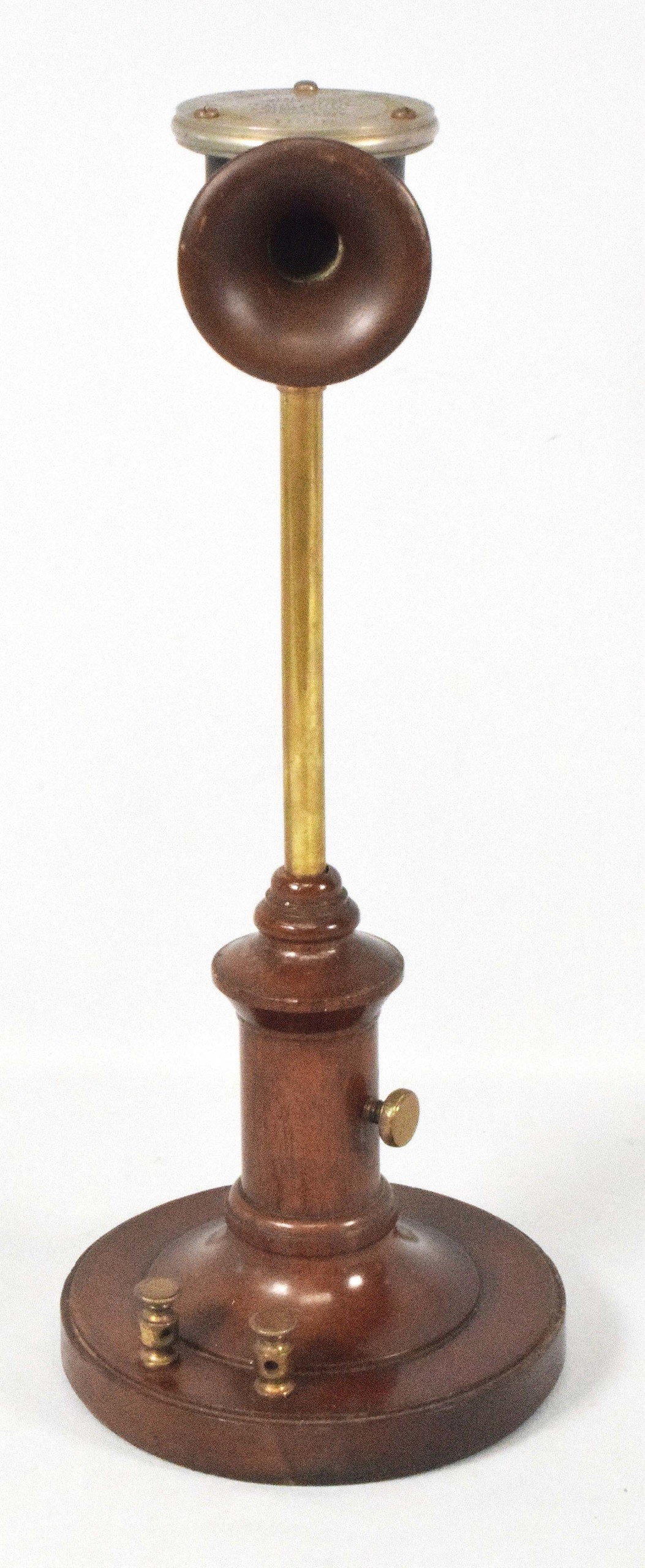
Far and away the star of the sale was an American Bell Telephone Company long distance transmitter that sold for $52,460. It had a wood and brass body, a wood and hard-rubber mouthpiece and a steel plate. The top displayed the several patent dates and the number #11319. The Smithsonian website informs us that the patent dates of 1886 and 1887 refer to Bell’s first long distance transmitter.
Review & Onsite Photos by Rick Russack
MIDDLEBOROUGH, MASS. — Auctions sometimes provide surprises. Sometimes big surprises, which are some of the reasons to attend a live sale as opposed to watching it online. Such was the case at White’s Auctions’ April 7 sale. One surprise was an empty metal trunk – not very large at 12 inches high and 18 inches long – described as a ship’s medical officer’s trunk with its top stenciled “Anchor Line SS Cameronia 1910 First Class.” Though it was estimated at $400/600, it sold to an internet bidder for $9,760! Why? The word “Heroin” stenciled decoratively on the front may have helped drive interest in the box. Or, maybe it was the fact that the Cameronia was sunk by a German torpedo in April 1917 while it was serving as a troop ship during World War I. When the bidding ended, the crowd immediately shouted out, “what’s in it?” and John White declared “nothing!” but it was the subject of much discussion in the hour or two that followed. The box makes an amusing anecdote, though it was far from the highest price of the day.
The top spot went to an early telephone and four other phones. It was in this group of phones that the sale’s highest prices were recorded. Regular clients at White’s are no longer surprised by this: over the course of the past several sales, the house has been selling a large collection of early phones, several of which have achieved five-figure prices. The April 2023 sale included two phones that each exceeded $40,000, their June 2023 sale had one that earned more than $18,000 and their December 2023 sale had one that brought more than $23,000. The best phones to be offered to date were in this sale. All were from one collection, assembled over decades by a someone who worked in the telephone industry; it is now being dispersed by his son. More than 20 phones were in this sale and the top 10, each of which brought five figure prices, collectively earned $283,650. In all, the phones attracted competitive bidding and grossed $328,000; nearly all were, appropriately, sold to phone bidders.
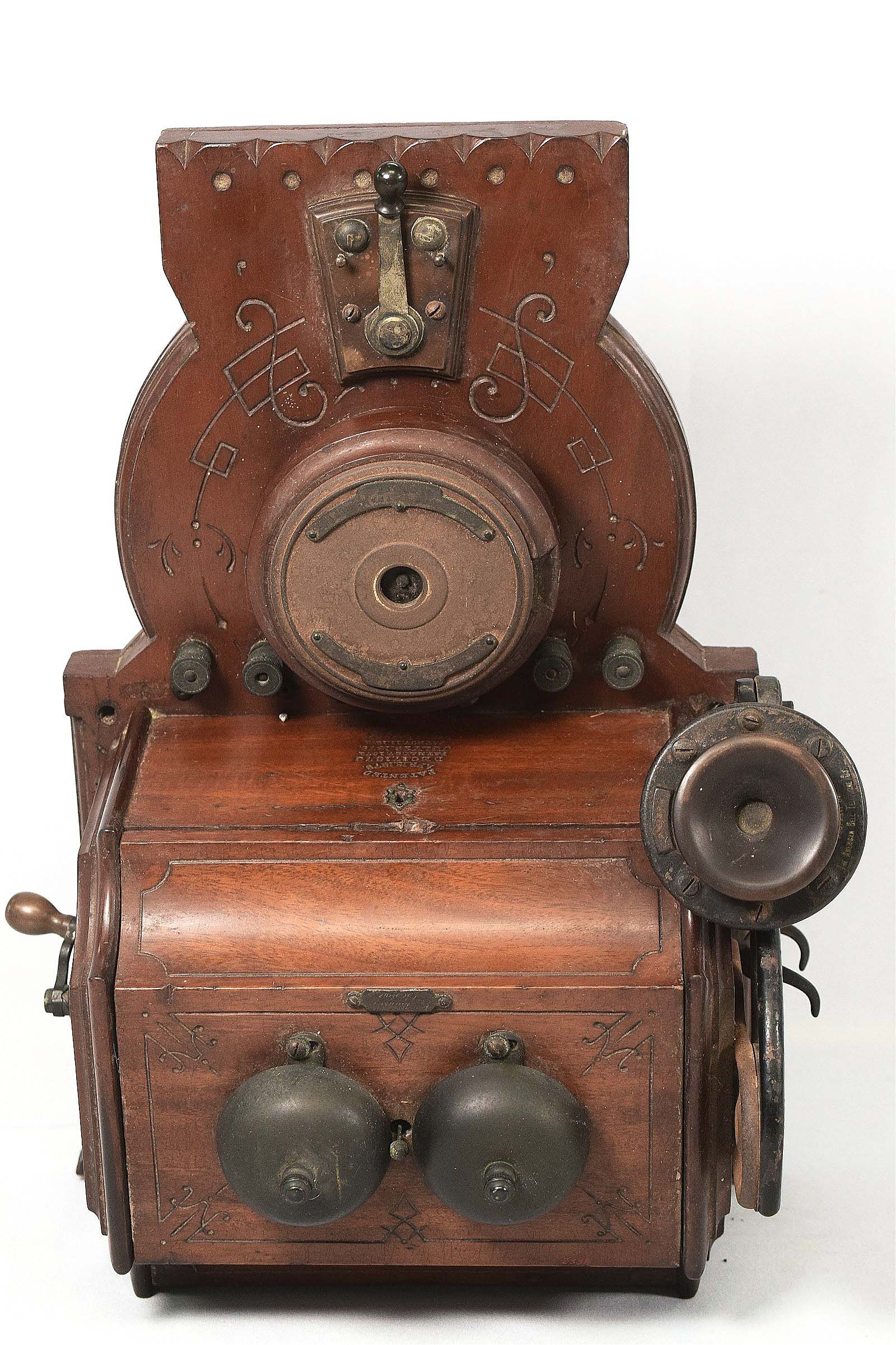
Two similar Charles Williams Jr wall phones each sold for $42,700. Williams was a manufacturer of electrical telegraph instruments at 109 Court Street in Boston.
The star of the group this time was an 1886-87 American Bell Telephone Company long distance telephone or transmitter with a wood and brass body, a wood and hard-rubber mouthpiece and a steel plate on top displaying its several patent dates and the number 11319. It sold for $52,460. The patent dates to 1876, the year of Bell’s first patent. It was in good condition, with only minor wear. Two circa 1879 Charles Williams Jr, wall phones each sold for $42,700. Alexander Graham Bell and Thomas Watson had their lab in Williams’ Boston building, also the site of the Palace Theatre, and it was in this building that the very first telephone call, “Watson, come here,” was made. A commemorative plaque marks the spot today. The first ever residential phone was installed in Williams’ home. Two wooden coffin type transmitters, each with an 1877 patent date and “other patents applied for,” sold together for $43,920.
Early telephones were a fraction of the sale. A small group of Midcentury Modern furniture produced more of the sale’s stronger prices. The highest of which was a walnut single butterfly coffee table made by George Nakashima that brought $19,250 from an internet buyer who outlasted an absentee bidder. A photocopy of the original Nakashima receipt was included, showing that it had been purchased in 1963 for $150, on an installment plan. The first payment was $50 in March 1963, with the balance paid about one year later. Four pieces of furniture made by Paul McCobb sold for more modest prices: his 1950s Planner Group desk sold for $458.
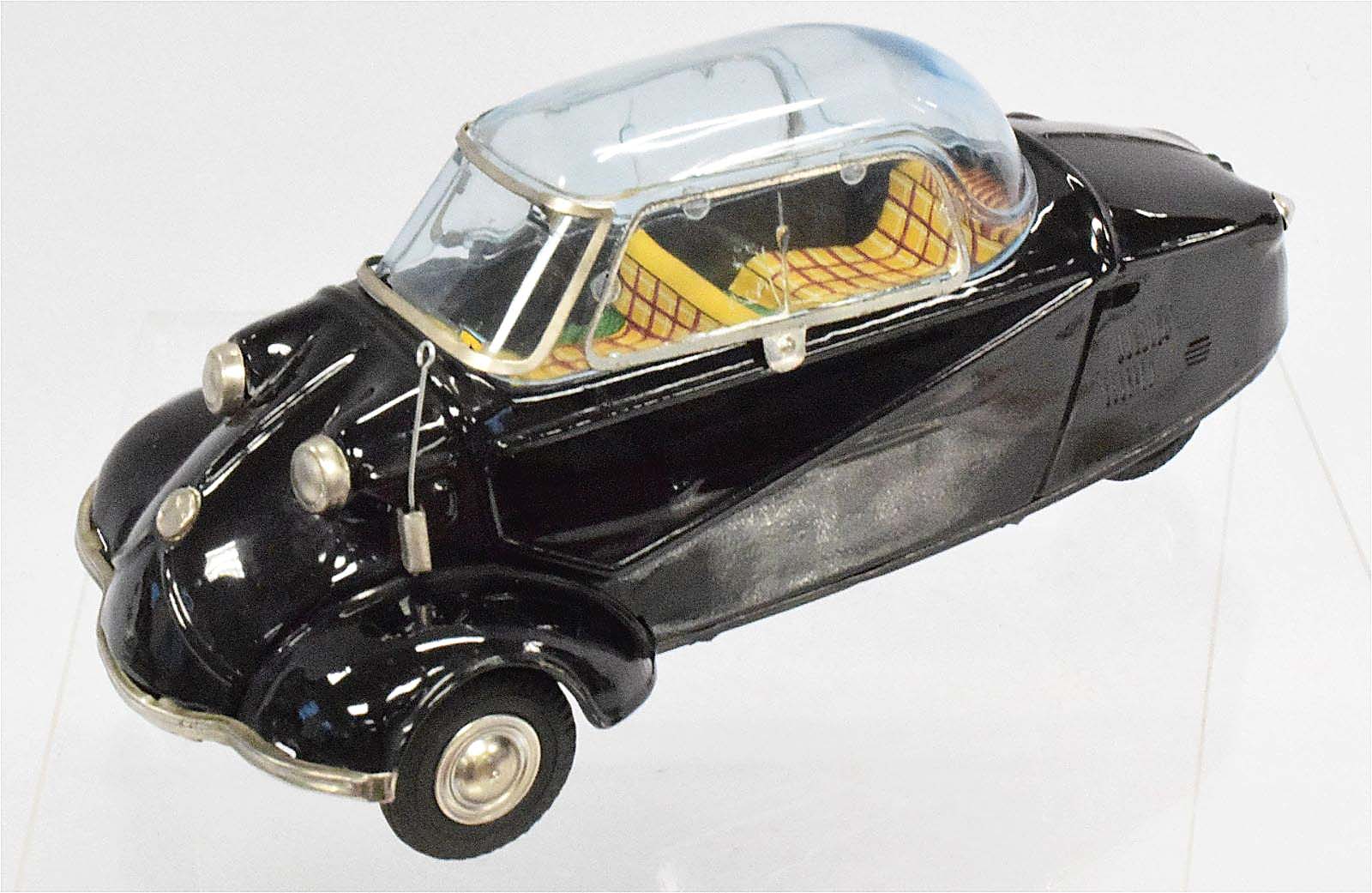
A large collection of Japanese tin friction-driven cars included this circa 1955 three-wheel Messerschmitt example, which was made by Bandai and had a fully lithographed interior, sold for $458.
A single-owner collection of more than 90 toys included a large selection of mint condition friction-driven automobiles, many in original boxes. The collector, now in his early 80s, had been a scrap dealer. He was meticulous about the condition of the toys he acquired and this care was reflected in the prices his toys achieved. Leading the selection was a brightly colored tin Rocket car, closely related to the Batman car, that was made in Japan by Aoshin. It sold for $3,172 to an internet bidder. Forty-one bidders had been watching this car prior to the start of the sale. Also doing well was a West German Gama Opel Kapitan friction car with its original box which earned $1,464. Some of the cars were unusual: a friction operated orange and white Zündapp Janus by Bandai sold for $1,037. A Japanese Bandai BMW 600 with a front opening door and a detailed, lithographed interior sold for $1,159. Other models included Rolls Royce, Mercedes, Lincoln and Jaguar, to name a few.
Cast iron toys included Arcade and Hubley motorcycles, which sold in the $500 to $700 range. An Arcade green Checker cab, with the original driver, brought $305. Pressed steel toys included a Buddy L tanker truck with an enclosed door-less cab ($854), a Sturditoy mail truck ($793) and a Buddy L flivver dump cart ($488).
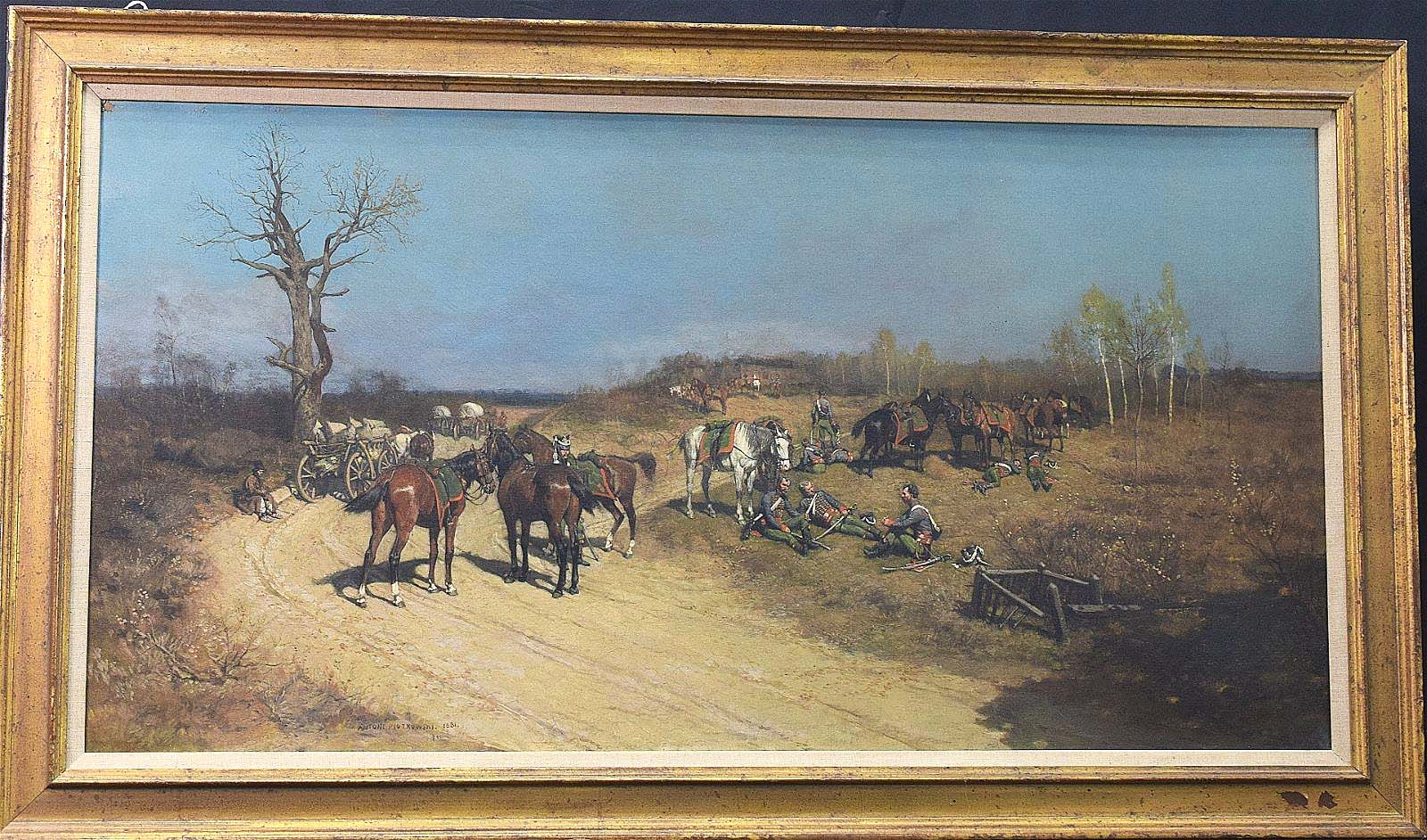
There were dozens of paintings in the sale. This military scene by Polish artist Antoni Piotrowski, titled or marked “Pozis,” was the star of the group and earned $9,760.
Paintings in the auction spanned a range of styles, from a realistic military scene by war correspondent and illustrator Antoni Piotrowski (Polish, 1853-1924) that achieved $9,760, to a pair of abstracts by Fred Fathinter (German, 1906-1974) which earned $732. A large impressionist lakeside scene, probably in Maine, by Charles Movalli (American, 1945-2016) earned $2,684 and an unsigned portrait of Euphemia Foote Whittredge, possibly by her husband Worthington Thomas Whittredge (American, 1820-1910), earned $854.
A collection of World War II memorabilia included several Japanese swords and daggers. A group of six “war trophy” swords, shipped home by an American soldier, remained in the crate they were shipped in. Included were two curved handle swords with brass handles and leather grips, two Samurai swords, a short sword and one other. Sold together, the group realized $4,270.
A group of three yellow-olive green bottles made by the Dyottville Glass Works for the West Point graduating class of 1846 sold for $6,710. Each had an applied seal commemorating the graduation. This was an illustrious class; 20 officers would become generals, including George McClellan, Stonewall Jackson and George Pickett. The bottles may have been made for the graduation party by the family of McClellan, who graduated second in the class. He served as the commander of Lincoln’s Army of the Potomac at the beginning of the Civil War.
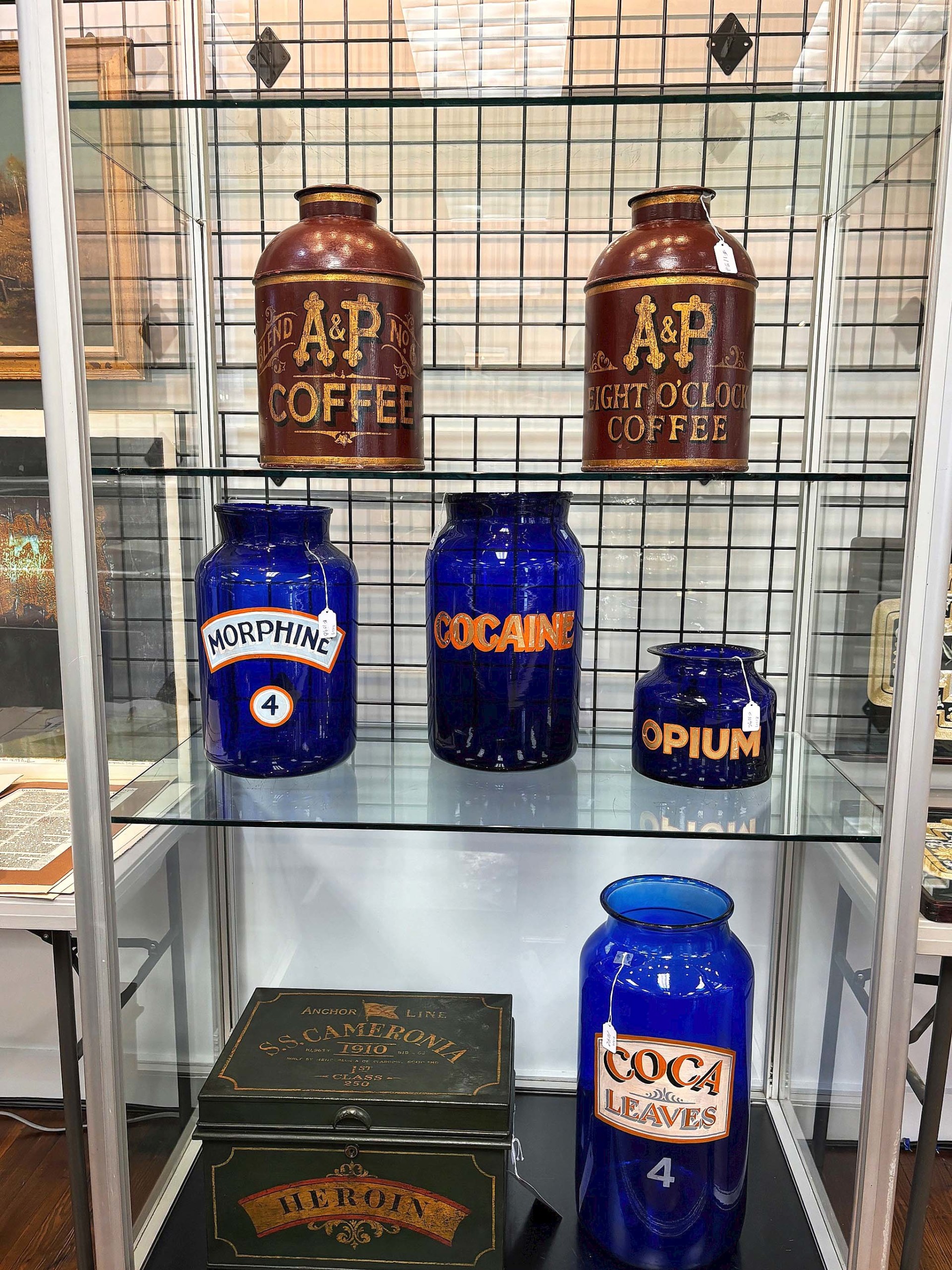
The pair of 14-inch-tall A&P coffee cannisters on the top shelf sold for $334.
There were large, deep blue glass storage jars for drugs, each with hand-painted lettering identifying the contents. A 20-inch-tall jar used to store morphine reached $1,342, one for coca leaves realized $1,098, and a smaller jar for opium realized $427. Much of the decorative glass dated to the Twentieth Century. An acid-etched Stueben vase with green dragons sold for $1,098; a signed and numbered Orrefors Graal vase, 8 inches tall, brought $732.
After the sale, John White said, “Obviously, we’re very pleased and so are our consignors. We grossed more than $625,000, so everybody is satisfied. It would be hard to categorize this sale — there was no strong theme — it was a variety of material. The phones, the toys and so many other things did well. We had a good crowd here. Our regulars were able to buy and so were the online bidders. It was a large sale but we finished by 6 pm and Kathyrn and I are quite happy with the results. Our next sale will be in late June and perhaps there will be more phones.”
Prices quoted include the buyer’s premium as reported by the auction house. For additional information, 508-947-9281 or www.whitesauctions.com.




